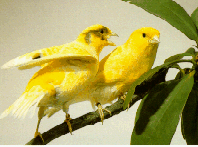HEN WATCHING
From Midwest Roller Club Newsletter by Kath Jesme

- Put a nest in the flight cage and watch to see who builds a nest and hunkers
down in it. The nest may also keep their minds in the right place; when I don't
put a nest in the flight, they try to sit in seed cups, instead.
I've noticed that, when those hens go into the breeding cage, they often try to
build in a seed cup instead of in the nest. A nest in the flight reminds them
of where they ought to start their serious business.
- Watch abdomen and vent feathers. As hens come closer to breeding condition,
their abdomens seem to enlarge and become "eggy" looking. You can almost see an
egg forming. The vent feathers also begin to protrude as the vent swells.
- Don't be fooled by "heat eggs". When you start increasing the light and
near 10 or 11 hours, some hens may get all excited and lay an egg. Probably
just one, and it's often blue. Leave her in the flight for at least a couple
more weeks, and she'll be more likely to lay a decent clutch first time out.

- Observe the way hens carry material. They're probably all carrying around
bits of paper and nesting material, if they can get any. The hens that carry
material in the back of their beaks are more likely to be getting ready to lay.
- Hens that squat on the perch and twitter when you whistle, or when they
hear a male (especially if he's singing hollow roll) are getting close.
- If you already have hens in breeding cages and they've built nests, watch
their water consumption. They seem to drink quite a bit more water the two
days before they lay their first egg.
- Don't forget that the cock needs to be in the cage at least 25 hours before
the first egg is laid in order for it to have any chance of being fertile.
Last modified: January 26, 2012
Comments? Please e-mail to: oircc@geocities.com
Return to OIRCC